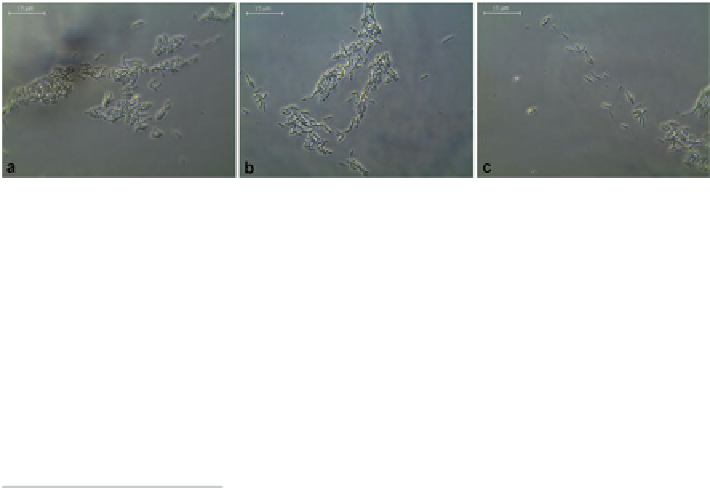Environmental Engineering Reference
In-Depth Information
Fig. 4
Phase contrast micrographs of KUMAs1 cells grown in nutrient broth supplemented
with 2 mM of arsenate (
b
) and 2 mM of arsenite (
c
) exposed for 4 h, and compared with
untreated cells (
a
)
Table 4
As(V) reduction by KUMAs1 under aerobic culture condition with different initial As(V)
concentration
Growth and As(V) reduction versus initial concentration of As(V) in
medium
0.07 mM 0.14 mM
0.21 mM
Growth
a
% reduction Growth % reduction Growth % reduction
24 4.43
8.23 4.93 10.12 5.21 11.42
48 6.27
19.57 8.48 32.34 8.93 32.98
72 5.04 17.73 7.87 29.79 8.76 31.56
96 3.93 13.54 7.24 28.96 8.09 29.65
a
Growth responses are presented as log number of CFU/ml. All the treatment regimes were inocu-
lated with same inoculum load as stated
Incubation
time (h)
~20 % after 48 h of incubation, which might be due to reduced growth. It seems at
lower concentration, growth phase was lengthened and thus slowed down As(V)
reduction. The result also indicates that minimum amount of As was needed for the
substantial growth of the bacteria as stated earlier. It was also earlier suggested that
the bacteria capable of As(V) reduction might be used as possible arsenic bioreme-
diation candidates in arsenic-contaminated environment (Bachate et al.
2009
;
Banerjee et al.
2011
; Jareonmit et al.
2012
).
Arsenic Removal
In this study, total As removal was found to be signifi cantly higher in comparison to
the As(V) reduction by the active cell mass of KUMAs1 under culture condition. The
amount of As removal by KUMAs1 increased with increasing cell mass (Table
5
).
After 48 h of incubation, cell mass removed ~55 % and ~56 % of total As when the
medium was supplemented with As(III) and As(V) respectively. It seems KUMAs1
could remove As following the same mechanism as hypothesized by Miyatake and
Hayashi (
2009
) in case of
Bacillus megaterium
strain UM-123, which could reduce
As(V) under aerobic conditions and could also remove As by adsorption.













































Search WWH ::

Custom Search